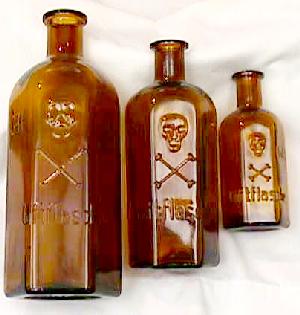
Definitions
Breakfast for Champions
Lunch Box Ideas
Sit Down Meals
Family Health Maintenance
Hygiene/Bath Essentials
Moms' Corner
Fourteen Most Important Foods to Eat Organic
Under the Sink, Over the Bath, and in the Laundry,--Natural Product Alternatives
Dangers of Plastics
Words to Live By
Who We Are
Recommended Reading
In Memory of Giant Ground Sloths. In Celebration of Cottonwood Trees."
--Dedication by Connie Barlow
in her book, Green Space, Green Time.
There is more to life than increasing its speed.
--Gandhi
Toxic Chemicals in Everyday Products,
Page Two
Optical brighteners: Optical brighteners are a broad classification of many different synthetic chemicals that, when applied to clothing, convert UV light wavelengths to visible light, thus making laundered clothes appear "whiter." Their inclusion in any formula does not enhance or affect the product’s performance in any way; they simply trick the eye. Optical brighteners do not readily biodegrade. They are toxic to fish when washed into the general environment and can create bacterial mutations. They can cause allergic reaction when in contact with skin that is then exposed to sunlight. Most optical brighteners are given trade names which consumers are unlikely to see on a label. Found in: Laundry detergents.
Organic solvents: A category of solvents and grease-cutters of mostly synthetic origin (organic in this instance refers to their petroleum origins). All chemicals in this category are generally neurotoxins and nervous system depressants, especially if contacted in sufficient quantity. Found in: All-purpose cleaners, degreasers and metal polishes.
p-Dichlorobenzene: (See Paradichlorobenzene)
Paradichlorobenzene: (also p-Dichlorobenzene, PDCB) A chlorinated synthetic of extreme chronic toxicity and environmental concern. Paradichlorobenzene is an endocrine disrupter and carcinogen. It does not readily biodegrade. Found in: Mothballs and deodorizers.
PDCB: (See Paradichlorobenzene)
Perchloroethylene: (also "Perc") A chlorinated solvent used most commonly in the dry cleaning process, "perc" is implicated in 90% of all groundwater contamination. Found in: Degreasers, spot removers, dry cleaning fluids.
Petroleum-based waxes: A broad category of synthetic waxes. Although they may appear in products like butcher’s wax, typically these are used for polishing or waxing in conjunction with a solvent and a spray. Once sprayed, the solvent evaporates (creating air toxins) and leaves the wax behind as a residue. Additionally, spraying is an inefficient way to apply a product and ingredients that rely on it for dispersal are suspect. Found in: Furniture polishes and floor waxes.
Petroleum distillates :(also naphthas). A broad category encompassing almost every type of chemical obtained directly from the petroleum refining process. Any ingredient listed as a "petroleum distillate" or "naphtha" should be suspect as it is, firstly a synthetic and, secondly, likely to cause one or more detrimental health or environmental effects.
Phosphates : A key nutrient in ecosystems, phosphates are natural minerals important to the maintenance of all life. Their role in laundry detergents is to remove hard water minerals and thus increase the effectiveness of the detergents themselves. They are also a deflocculating agent; that is, they prevent dirt from settling back onto clothes during washing. While relatively non-irritating and non-toxic in the environment, they nonetheless contribute to significant eutrophication of waterways and create unbalanced ecosystems by fostering dangerously explosive marine plant growth. For these reasons they are banned or restricted in many states. Products containing phosphates should be considered unacceptable. Almost all dishwasher detergents contain phosphates. Found in: Laundry detergents. All-purpose cleaners, dishwasher detergents.
Phosphoric acid: (also mataphosphoric acid, orthophosphoric acid). Phosphoric acid is included as a toxic chemical on the EPA’s Community Right-to-Know list.. It is also controlled under the Clean Air Act as an air pollutant. OSHA regulates the maximum allowable levels in the workplace to protect workers. Found in: Bathroom cleaners.
Polycarboxylates: Similar in chemical structure to certain plastics and acrylic compounds, these are relatively new, synthetic phosphate substitutes. Because they are recent additions to the consumer product chemical arsenal, however, their effects on human and environmental health remain largely unknown. Though tests show they are non-toxic, do not interfere with treatment plant operation and generally settle out with the sludge during water treatment, until further study and analysis are conducted, use of this ingredient is not recommended. Further, they are not biodegradable and are petroleum based. Found in: Laundry detergents, all-purpose cleaners and dishwasher detergents.
Polyethylene glycol: (also PEG). Another type of anti-redeposition agent, PEG is a polymer made from ethylene oxide and is similar to some non-ionic detergents. Not considered toxic, it takes large doses to be lethal in animals. However, PEG is slow to degrade and is synthetic.
Propylene glycol: A synthetic solvent much like ethylene glycol. Propylene glycol can penetrate the skin, causing liver abnormalities and kidney damage, according to Material Safety Data Sheets. However, compared to ethylene glycol, propylene glycol is less toxic.
Quaternium 15: An alkyl ammonium chloride used as a surfactant, disinfectant and deodorant that releases formaldehyde, a potent toxin. Found in: Detergents, deodorizers, disinfectants.
Soda lye: (See sodium hydroxide)
Sodium dichloroisocyanurate:(See chlorine)
Sodium Fluoride(See Fluoride)
Sodium hydroxide: (also lye, caustic soda, white caustic, soda lye). Sodium hydroxide is derived from the electrolysis of brine sea water as a co-product of chlorine. It is a strong, caustic substance and causes severe corrosive damage to eyes, skin and mucous membranes, as well as the mouth, throat, esophagus and stomach. Injury can be immediate. Blindness is reported in animals exposed to as little as 2% dilution for just one minute. Skin is typically damaged to 0.12% dilutions for a period of one hour. Tests with healthy volunteers exposed to the chemical in spray from oven cleaners showed that respiratory tract irritation developed in 2 to 15 minutes. Sodium hydroxide is included as a toxic chemical on the EPA’s Community Right-to-Know list. It is also a controlled substance in the workplace, and OSHA has set limitations on concentrations in the air. Found in: Oven cleaners, drain cleaners
Sodium hypochlorite: (See chlorine)
Sodium Lauryl Sulfate (or SLS) and Sodium Laureth Sulfate (or SLFS): SLS and SLFS are eye and skin irritants. Infants and children, whose eyes are developing at a more rapid pace than adults, are more susceptible to accumulation of SLS in eye tissues. Exposure to SLS causes improper eye development in children, since it is absorbed systemically through skin.
SLS is lethal to fresh water fish at 7ppm and does not break down well in the environment.
Materials Safety Data Sheets caution workers to avoid body contact with SLS. However, this same chemical is actively put into body care and hair products. SLS and SLFS are both found in shampoo's, toothpaste, dishwashing liquids, soaps, actually, anything that produces a rich and foamy lather.
If this information isn't enough, research has shown that both of these substances may cause carcinogenic nitrates, NDELA, and dioxins to form when combined with commonly used ingredients in a single bottle of shampoo. Large amounts of nitrates, aking to eating a full pound of nitrate-laden bacon, would then be assimilated into the body with just one shampooing--(from a 1978 FDA report).
Stoddard solvent: A petroleum distillate used as a solvent and degreaser. (See kerosene) Found in: All-purpose cleaners and abrasives.
Surfactants: Found in: Laundry products, all-purpose cleaners, dish detergent and dish liquids, and other common cleaning products.
Talc: Symptoms of exposure to this compound may include eye irritation, scarring of the lungs, shortness of breath and coughing. Massive inhalation can cause dyspnea, tachycardia, tachypnea, cyanosis and fever. Chronic exposure can cause heart failure. Talc can be acutely dangerous to an infant when the container tips over in a child’s face. The powder can suffocate a child, and may result in death. Long-term application of talc to the genital area may increase the risk of ovarian cancer in females.
Tetrapotassium pyrophosphate/ Tetrasodium pyrophosphate: Basic phosphates (tetrasodium being the more common of the two) used to reduce water hardness. (See phosphates above) Found in: Laundry detergents, all-purpose cleaners
Titanium Dioxide: Can be absorbed through the skin. The U.S. government's National Institute for Occupational Safety and Health (NIOSH) labels the chemical "a potential occupational carcinogen." Titanium dioxide is an opaque powder that is approved for use as a colorant in food, in drugs, and in cosmetics. It is found in such things as prescription prenatal vitamins, (but so is shellac), sunscreens, and processed foods.
Trichloroethane: (also methyltrichloromethane, TCA, methyl chloroform, chloroethane). A chlorinated solvent used for cleaning and degreasing, it is known to contribute to depletion of stratospheric ozone and will be phased out by 2002. Trichloroethane is listed in the 1990 Clean Air Act as a hazardous air pollutant and is on the EPA’s Community Right-to-Know list.
Triethanolamine: (See diethanolamines)
Xylene sulfonate: Xylene is a synthetic that, when reacted with sulfuric acid, creates a surfactant. Slow to biodegrade in the environment and moderately toxic. Found in: Laundry products, all-purpose cleaners, dish detergent.
Back

